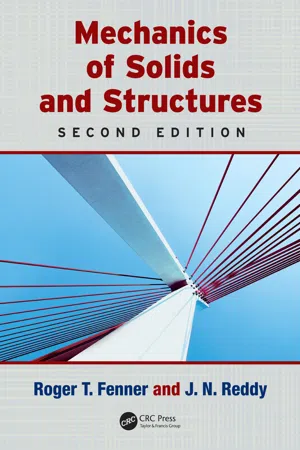Technology & Engineering
Beam Bending
Beam bending refers to the deformation of a structural beam under the influence of external loads, causing it to bend or flex. This phenomenon is a fundamental concept in structural engineering and is crucial for designing and analyzing the behavior of beams in various applications. Understanding beam bending is essential for ensuring the structural integrity and safety of buildings, bridges, and other load-bearing structures.
Written by Perlego with AI-assistance
Related key terms
1 of 5
4 Key excerpts on "Beam Bending"
- O.P. Gupta(Author)
- 2022(Publication Date)
- Routledge(Publisher)
Chapter 6 BEAMS, PLATES AND SHELLS DOI: 10.1201/9780203756041-66.1 INTRODUCTION
Beams and plates form important elements of structures, pressure vessels and machines. Analysis of indeterminate structures formed of beams of uniform and non-uniform cross-section subjected to various types of loading including bending, twisting or direct load calls for very special efforts and the finite element method comes in very handy in these situations. Automobile chassis, cranes, underframe of railway bogies and machine beds are a few typical examples from the field of mechanical engineering besides building structures, bridges etc. which can be analyzed using beam elements. All pressure vessels containing gas or liquid under pressure, boilers, submarines, ship decks and machine frames are examples of plate structures. The complex configuration and nature of loading makes the finite element technique the only viable approach for solving such problems. Problems of sheet metal forming of automobile body parts (including its die design) have also been tackled using large-displacement plate bending analysis [1 , 2 ]. Beam and plate problems are similar in that both are loaded in bending and other types of stress may often play a secondary role. This makes the form of deflection expression and subsequent analysis similar in the two cases.6.2 BENDING OF BEAMS
A beam of non-uniform cross-section loaded in the transverse direction is shown in Fig. 6.1. It is divided into elements, such as 1-2, 2-3 etc. One of the elements (say 2-3) is redrawn in Fig. 6.2 and is denoted as 1-2 for convenience. We shall analyze the stresses due to bending of this element. Before that let us define a few related quantities, such asdpending moment, slope, deflection, rotation and the sign conventions for these. Generally the beam, subjected to bending, is assumed to deflect in a plane passing through the neutral axis. If the beam is aligned along the x-axis, it may deflect either in x-z or x-y planes, as shown in Fig. 6.2(- eBook - PDF
- Roger T. Fenner, J.N. Reddy(Authors)
- 2012(Publication Date)
- CRC Press(Publisher)
309 6 Bending of Beams: Deflections In Chapter 5 we developed methods for finding the distributions of shear force and bending moment in statically determinate beams, based on equilibrium conditions for forces and moments. We also saw how to determine the distributions of bending and shear stresses in any beam, once the bending moments and shear forces are known. In many practical applications, the amount by which a beam deforms is as important as its ability to support the applied loads without failing. We must therefore develop methods for evaluating this deformation. Here it is not so much the internal strains within the beam which are important, but rather the lateral displacements or deflections of the whole beam cross-section. If the beam is statically indeterminate, we cannot even find the forces, moments, and stresses without also considering deflections. There are two modes of deformation of a beam which contribute to its deflection. Consider, for example, the cantilever shown in Figure 6.1(a), which is subjected to a concentrated force at its free end. Under the action of the resulting bending moment distribution in the beam, it bends into the form of a curve, which is shown much exaggerated in Figure 6.1(b). It is this deformation that we considered when analyzing bending stresses in beams in Chapter 5: if the bending moment in the beam were constant, the curve would be an arc of a circle. The lateral deflection involved, such as v b at the free end, is the bending deflection of the beam. On the other hand, the application of a concentrated force at the free end creates a shear force at each and every cross-section of the beam which is equal in magnitude to the applied force. This is essentially the shearing situation we encountered in Figure 1.23, and we can expect the beam to suffer shear deformation, as shown in Figure 6.1(c), again much exaggerated. The lateral deflection involved, such as v s at the free end, is the shear deflection of the beam. - eBook - ePub
- Fathi Al-Shawi(Author)
- 2023(Publication Date)
- Jenny Stanford Publishing(Publisher)
Chapter 4 Bending of BeamsBeams are straight members subjected to loads acting between the supports and usually in the direction of gravity, i.e. along the z-axis. The boundary conditions may include fixed, hinged, roller, elastically restrained, or free types of support. The beam may be prismatic, i.e. with a constant cross section otherwise it is non-prismatic. In this book only prismatic beams are treated in detail. When a case of non-prismatic beam is encountered then the beam may be divided into elements, each of which is assumed to have constant cross section leading to an approximate solution and the accuracy can be improved if the number of elements is increased.The beam under load will deform undergoing deflections and rotations due to the curvature of the deflection curve and the actions developed in the beam are bending moments and shear forces.4.1 Derivation of Beam Stiffness Matrix
The stiffness matrix of a beam is the relationship between the actions (forces and moments) and displacements (translational and rotational) at the ends of the beam.The derivation of the stiffness matrix is based on the local coordinates system x̅,y̅,z̅ with the x̅ -axis running along the axis of the beam. The displacements and forces are relative to the local x̅ -axis thus they are written with a bar.Consider a beam subjected to forces and moments Z̅i and M̅i at node i and Z̅j and M̅j at node j as shown in Fig. 4.1. The beam will deform from its initial straight horizontal position into the shape shown with the translational and rotational displacements w̅i and θ̅i at node i and w̅j and θ̅i - eBook - ePub
- Robert L. Mott, Joseph A. Untener(Authors)
- 2021(Publication Date)
- CRC Press(Publisher)
The examples presented here will concentrate on these items. Also of interest to the designer are cost, appearance, physical size, weight, compatibility of the design with other components of the machine or structure, and the availability of the material or beam shape. Deflection of the beam may also be a consideration, and that topic is presented in Chapter 9. Two basic approaches will be shown for beam design for strength: One involves the specification of the material from which the beam will be made and the general shape of the beam (circular, rectangular, W-beam, etc.), with the subsequent determination of the required dimensions of the cross section of the beam. The second requires specifying the dimensions and shape of the beam and then computing the required strength of a material from which to make the beam. Then, the actual material is specified. Design Stress for Metals: General Guidelines The flexure formula, and all preceding work in this chapter, are used to determine applied bending stress, in other words the stress that will actually occur inside of the beam while loaded. Of course a beam will be safe if, and only if, this applied stress is less than the design stress. Design stress is, of course, the maximum allowable stress that designer determines to be safe for the particular application. When specifying design stresses, it is important to keep in mind that both tensile and compressive stresses are produced in beams and this may affect the approach to determining the design stress. If the material is reasonably homogeneous and isotropic having the same strength in tension or compression, then the design is based on the highest stress developed in the beam. Most wrought metals, such as steel, aluminum, and titanium, behave in this fashion
Index pages curate the most relevant extracts from our library of academic textbooks. They’ve been created using an in-house natural language model (NLM), each adding context and meaning to key research topics.



